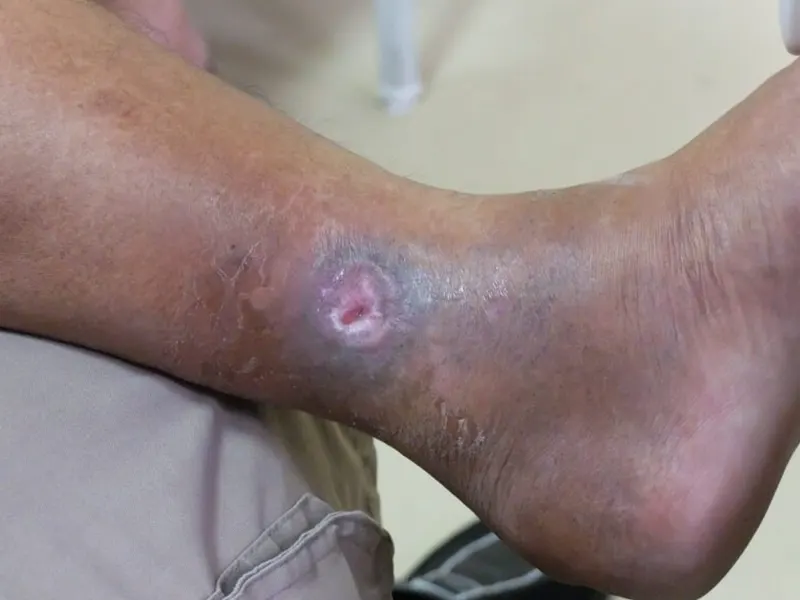Venous Ulcers
For patients suffering from venous ulcers, living with leg wounds can be a miserable, drawn out experience. Three of the many difficulties people with venous ulcers face include: frequent trips to a wound care center, dressing changes, and the daily use of compression stockings, which may provide temporary relief, at best.

What are Venous Ulcers?
The most severe stage of venous insufficiency is the development of venous ulcers. These types of wounds form on the leg, generally along the inner part of the ankle or lower calf, and are typically found in patients who are already displaying clear symptoms of venous insufficiency. Ulcers usually occur in areas where the skin has already become dark and abnormal due to a lack of oxygen and nutrients. These open wounds form as a result of the extremely poor circulation occurring in the skin due to the underlying venous insufficiency.
Approximately 1% of the adult population suffers from these chronic, non-healing wounds on the lower legs and ankles, with the number jumping to 3% for those over 65. Venous ulcers often start off as small scrapes or cuts that progress into larger, and deeper wounds. Even with intense wound care, constant use of compression, and leg elevation, the wounds often take several months to heal. It is important to understand that even after healing, about 60% of these wounds will come back within a year, unless the underlying circulation problem is addressed
Venous leg wounds are often present for extended periods of time because patients ignore them until they become too large or painful to deal with at home. Unfortunately, even when patients consult a medical professional, many doctors lack the knowledge and expertise to correctly identify and treat these types of leg wounds and they are frequently misdiagnosed.
How To Treat Venous Ulcers?
There is good news though! Venous ulcers don’t have to be a painful and long lasting problem. The first step towards healthy legs for venous ulcer patients should be an evaluation by a vein specialist such as Dr. Siragusa. At Siragusa Vein and Laser, the experienced team will accurately evaluate each patient’s unique situation and come up with a custom treatment plan based on the findings of your venous duplex ultrasound.
If you do have a venous ulcer, it’s time to correct your circulation and say goodbye to wound care, compression stockings, and dressing changes. The same minimally invasive, office-based procedures we perform here at Siragusa Vein and Laser to treat varicose veins are also utilized to correct the circulation for patients with venous ulcers. These include radiofrequency ablation, endovenous laser therapy, Varithena, ultrasound-guided sclerotherapy, and micro-phlebectomy.
Getting Your Insurance To Cover Your Vein Treatment
Many of our patients are very surprised to learn that Insurance often covers the treatment of symptomatic varicose veins. The insurance specialists at Siragusa Vein and Laser have compiled a list of ways to get your insurance provider to cover your treatment.
Take The First Step
Take the first step towards reclaiming healthy, pain-free legs that take you where you want to go. If you or someone you know is suffering from venous ulcers or a problem that resembles the images in this section, we can help! Contact us at Siragusa Vein and Laser and schedule a consultation at one of our two conveniently located offices in Nashville and Hermitage. Reach out to us today and let us help you restore your circulation and say goodbye to the pain and discomfort of venous ulcers.
